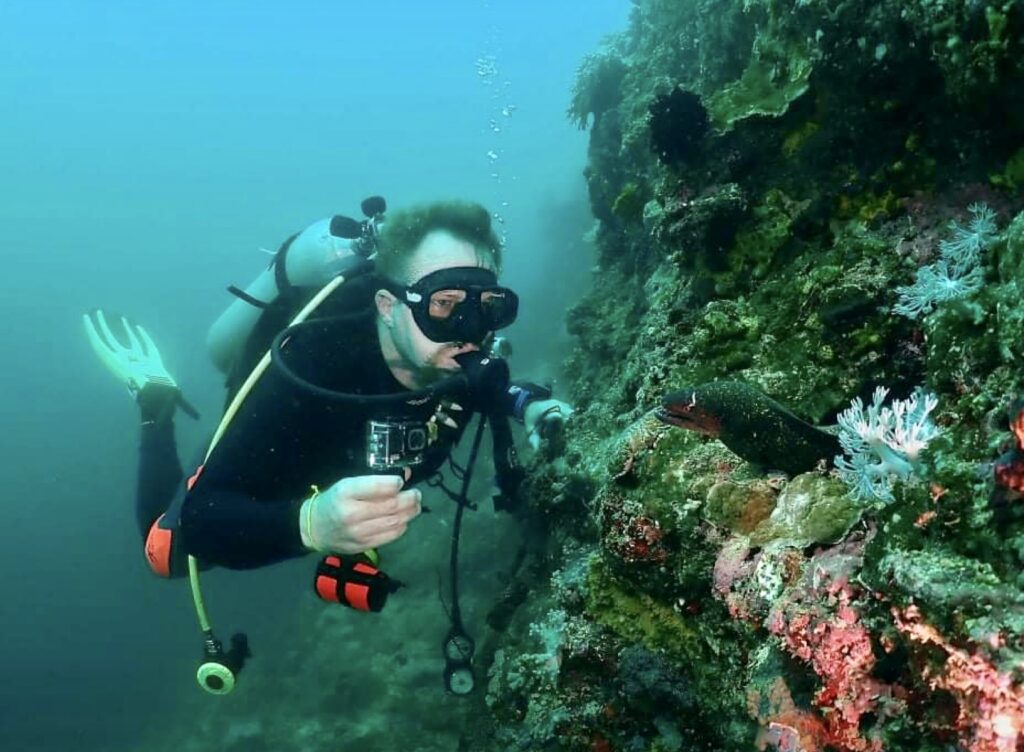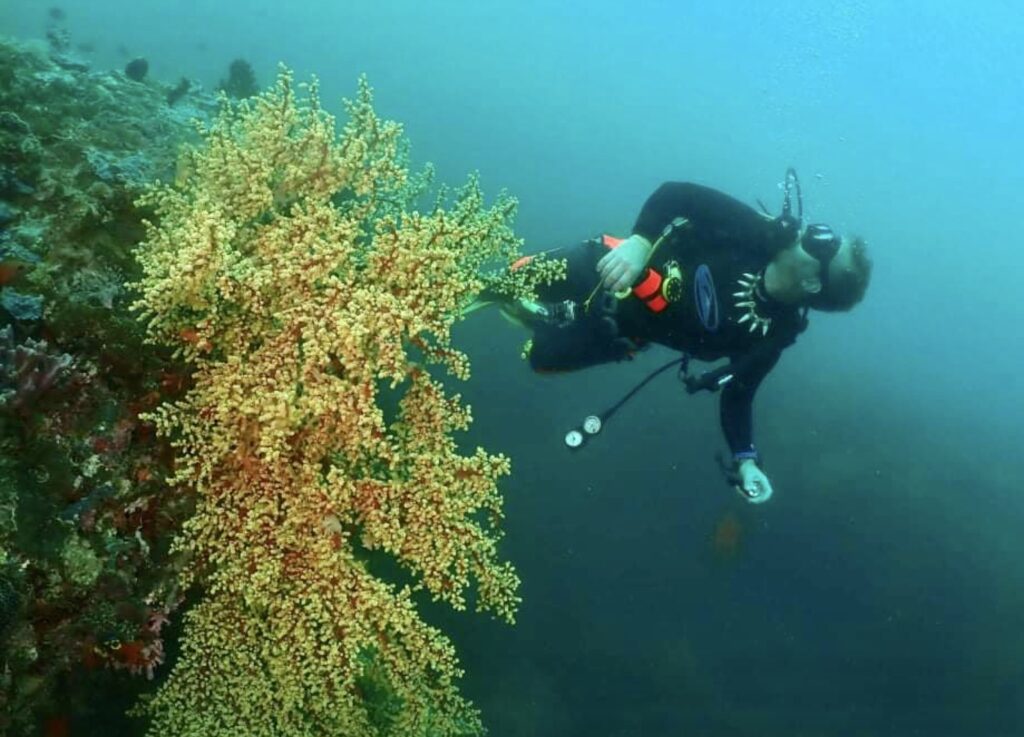Text by Henrylito D. Tacio
Photos by Darrell Blatchley
Although corals look more like plants or rocks, they are actually animals that are essential for the planet. But here in the Philippines – which is composed of more than 6,000 islands – they are on the verge of extinction.
In the late 1970s, a study conducted by the East-West Center in Hawaii showed that more than half of the coral reefs in the country were “in advanced states of destruction.” Only about 25% of live coral reef cover were in “good condition,” while only 5% were in “excellent condition.”
Reefs are considered in “excellent condition” if live hard and soft coral cover over 75% of the area. It is considered “fair” if the cover is from 25% to 50% and “poor” if the cover is 0% to 25%.
In 2014, a nationwide assessment was initiated to update the information status of the country’s coral reefs by the biology department of the De La Salle University. The 93-million study was funded by the Philippine Council for Agriculture, Aquatic and Natural Resources Research and Development (PCAARRD) of the Department of Science and Technology (DOST).
Dr. Wilfredo Y. Licuanan, leader of the study, and his team surveyed randomly selected 206 reef stations from 2014 to 2017, and another 101 stations were monitored from 2015 to 2018.
No excellent category reefs were found in the recent surveys around the country, the findings of the study showed, which was published in Marine Pollution Bulletin. But what is alarming is that about a third of the reef corals were lost over the last decade, the study found out.
“We lost roughly a third of the coral in 20 years and we lost our ‘excellent’ category corals in the last 40 years,” Dr. Licuanan was quoted as saying by Business World.
“Nowhere else in the world are coral reefs abused as much as the reefs in the Philippines,” deplores Don C. McAllister of the Ocean Voice International, who has conducted studies on the status of the country’s coral reefs in the past.
The country’s coral reefs are the second-largest in Southeast Asia, according to the Union of Concerned Scientists (UCS). They cover 26,000 square kilometers and support extraordinary biodiversity: more than 400 species of hard coral – 12 of which are unique to the area – and more than 900 species of reef fish.
Most Filipinos live near the seas. These residents depend on the tremendous natural resources for fishing, tourism, and storm protection, valued at more than US$2 billion annually.
And yet, coral reefs are hardly protected. Among the threats that made coral reefs in a perilous state include destructive fishing techniques, coastal development, forest denudation, and aquaculture.
Today, they are further threatened by climate change. “(The reefs) cannot afford two additional major stresses posed by climate change,” the UCS deplores. “These include further increase in ocean temperature, which can trigger coral bleaching and ocean acidification, which at critical thresholds makes it difficult for corals to build shells and skeletons.”
Rising temperatures, scientists say, increase the risk of coral bleaching. When waters get too warm, corals release their colorful micro-algae, turning a skeletal white color. Some glow by naturally producing a protective layer of neon pigments before they bleach.

Colorful corals (Darrell Blatchley) 
Coral reefs and fish (Darrell Blatchley) 
Beautiful coral (Darrell Blatchley)
Coral bleaching
A sudden or abrupt change in temperatures is bad for corals as it leads to stress that causes coral bleaching, and eventually, the death of corals. “Bleaching is not a good thing,” explained Dr. Terry Hughes, a distinguished professor at James Cook University in Australia.
“Bleaching can be thought of as the ocean’s version of the ‘canary in the coral mine’ since it demonstrates corals’ sensitivity to dangerous and deadly conditions,” said the Sixth Status of Corals of the World: 2020 Report.
“Even small increases in water temperature can cause coral bleaching,” the UCS said, adding that since 1950, global mean sea temperatures have risen roughly 1°F (0.6°C).
The Philippines had its first mass coral bleaching at the end of the twentieth century.
Ocean acidification
But what concerns most marine scientists around the world is ocean acidification, climate change’s evil twin. “Carbon dioxide in the atmosphere eventually finds its way to and dissolves in the oceans, causing the water to become ‘acidic’… reducing the ability of the coral reefs to deposit calcium carbonate or calcify,” explained Dr. Edgardo Gomez, the founding director of the University of the Philippines Marine Science Institute.
Scientists say not all of the carbon dioxide emitted by human industrial activities remains in the atmosphere. Between 25% and 50% of these emissions over the industrial period have been absorbed by the world’s oceans, preventing atmospheric carbon dioxide build-up from becoming worse.
But this atmospheric benefit comes at a considerable price. “As a result, the sea water becomes more acidic and the concentration of carbonate ions decreases,” explains Forest Rohwer, author of Coral Reefs in the Microbial Seas. “Carbonate ions are required by corals, crustose coralline algae, and other marine organisms for building their skeletons and shells. The increasing ocean acidification that lies ahead will affect even the most remote coral reef ecosystems.”
Marine scientists claim the average pH (the concentration of hydrogen ions in a solution) of the ocean has already decreased about 0.1 pH unit from pre-industrial values, a shift that corresponds to a 30% increase in the concentration of hydrogen ions and a decrease in carbonate ions. “This has decreased the rate at which reef-building corals build their skeletons (their rate of calcification) by 20%,” Rohwer writes.
Ocean pH is projected to decrease another 0.3 to 0.4 pH units by the end of this century. This much change in pH is predicted to reduce coral calcification rates to 40-60 percent of normal. “This is a momentous change,” Rohwer notes.
“Imagine dripping hydrochloric acid onto chalk,” says André Freiwald of the University of Erlangen-Nuremberg, one of the authors of a study that appeared in the professional journal Frontiers in Ecology and the Environment. “The chalk would disintegrate immediately; the corals could face a similar fate.”
The acidification, Dr. Gomez added, may be gradual but would happen simultaneously all over the world. He warned that it would be worse than the acidification of agricultural lands due to the use of chemical fertilizers. “Land is more manageable. With the use of organic fertilizer and chemicals, land can easily recover. But once the ocean becomes acidic, it would take millions of years to bring back their natural (state).”
Sea level rise
Another effect of climate change on coral reefs is sea-level rise. As the US National Oceanic and Atmospheric Administration puts it: “Sea level rise may lead to increases in sedimentation for reefs located near land-based sources of sediment. Sedimentation can lead to the smothering of corals.”
Sea level rise has fluctuated through the course of the earth’s history. The Nobel laureate Intergovernmental Panel on Climate Change (IPCC) estimated a sea-level rise somewhere in the magnitude of 10-30 centimeters by about 2030 and 21-71 centimeters by the year 2070, and about one meter in the twenty-second century.
Human activities
Climate change and its aftermaths (coral bleaching, ocean acidification, and sea-level rise) are just recent threats to coral reefs. All the threats have one thing in common: human activities.
Destructive fishing methods – ranging from dynamite blasts to cyanide poisons – are destroying vast areas of the reef. Fishermen blast reefs with dynamite to stun the fish. When fish float to the surface, fishermen scoop up large quantities at once. Heavily dynamited reefs produce only 2.7 to 5 metric tons per square kilometer per year compared to 30 metric tons for healthy reefs.
In many parts of the world, natural poisons have long been used in fishing without apparent damage. But such is not the case with sodium cyanide. In the Philippines, 80% of the exotic fish destined for pet shops and aquariums throughout Europe and North America are captured using cyanide. There is also a growing demand for live fish at upscale restaurants.
Another equally destructive fishing method is the muro-ami, a drive-in net used for fishing in coral reefs. It consists of a net bag with two long wings into which the schooling fish, like the dalagang bukid, are driven by the divers. The gear utilizes vertical scarelines weighed down by stones or chain links for creating a disturbance that drives out the fish from the coral reef into the net.
Coral mining has also depleted the country’s reefs. In fact, an estimated 1.5 million kilograms of corals are harvested annually as part of the international trade in reef products.
Also contributing to the destruction of coral reefs are sedimentation from erosion of soil from deforestation; the quarrying of coral reefs for construction purposes; pollution from industry, mining, and municipalities; and coastal population growth.
Oldest ecosystem
Coral reefs have existed for perhaps 500 million years, making them one of the oldest ecosystems on the planet. The creation of a reef can take centuries. Reefs are constructed by millions of minute animals called coral polyps, each of which lives inside a protective limestone skeleton.
The coral’s skeletons amass to form the foundation of a reef. The stony structures grow slowly, normally at a rate of 0.25 centimeters to 0.5 centimeters a year.
The Department of Environment and Natural Resources (DENR) urges every Filipino to help save the country’s remaining coral reefs. “We must act now to save our remaining coral reefs, before it’s too late,” the DENR said in a statement published on its website.

